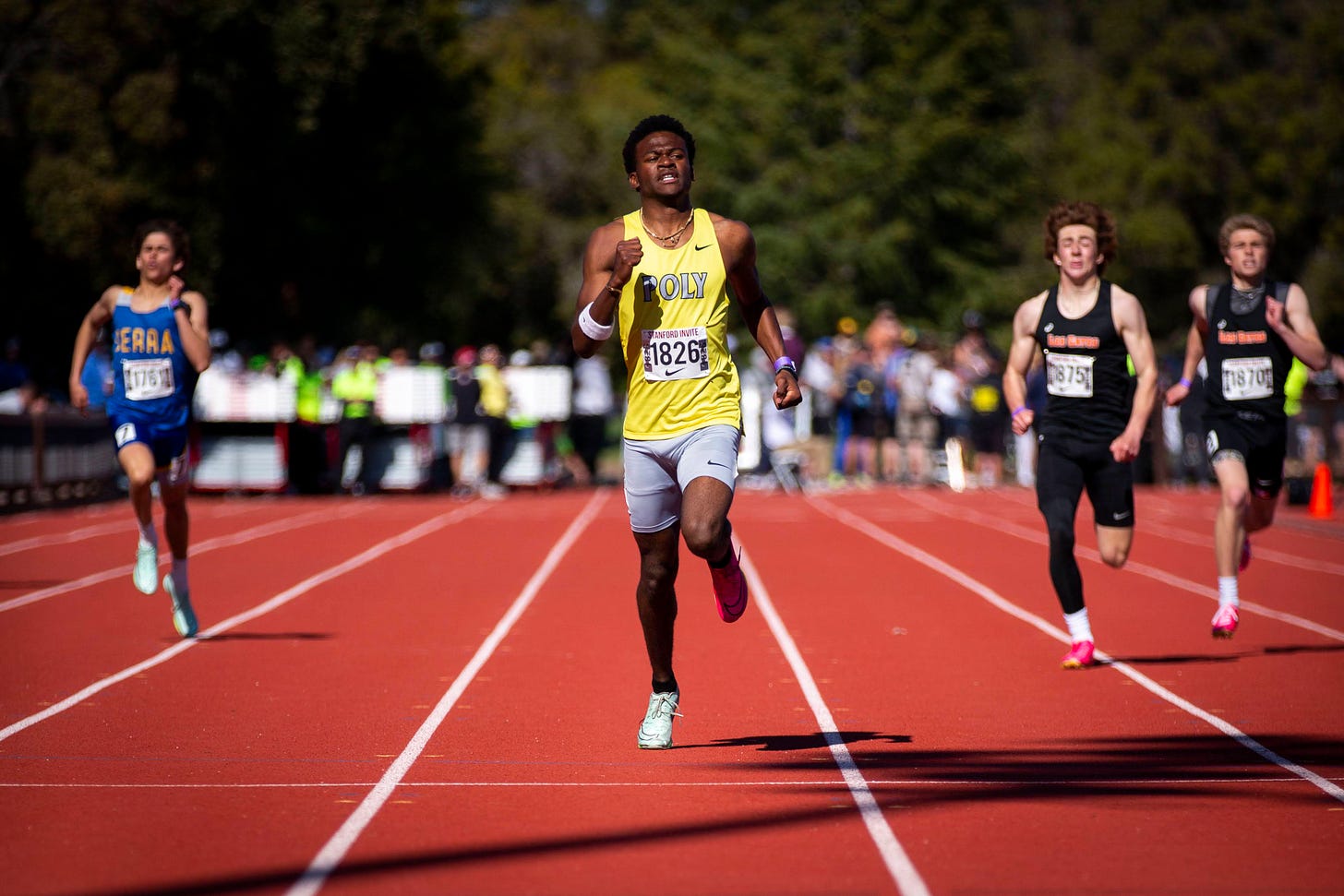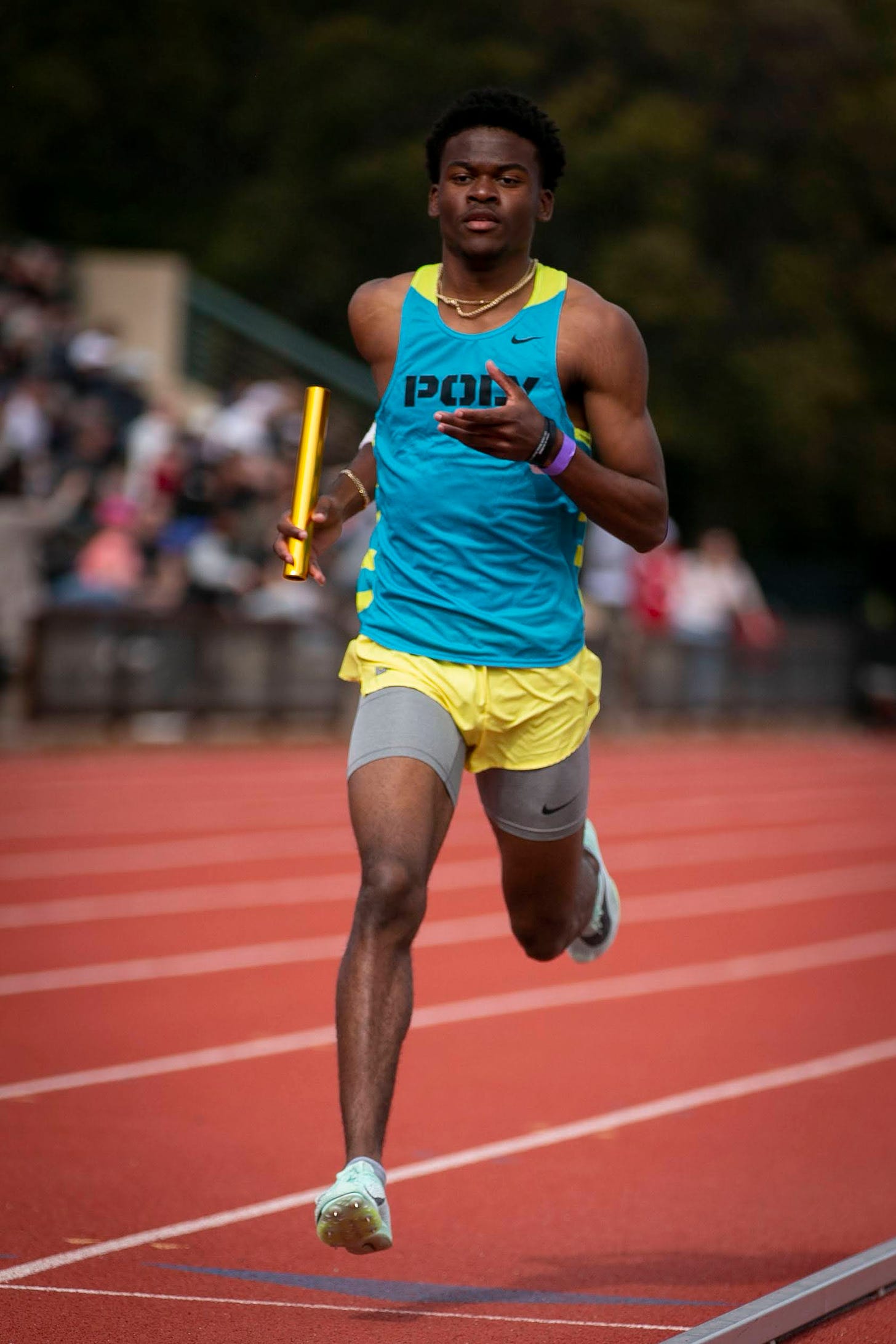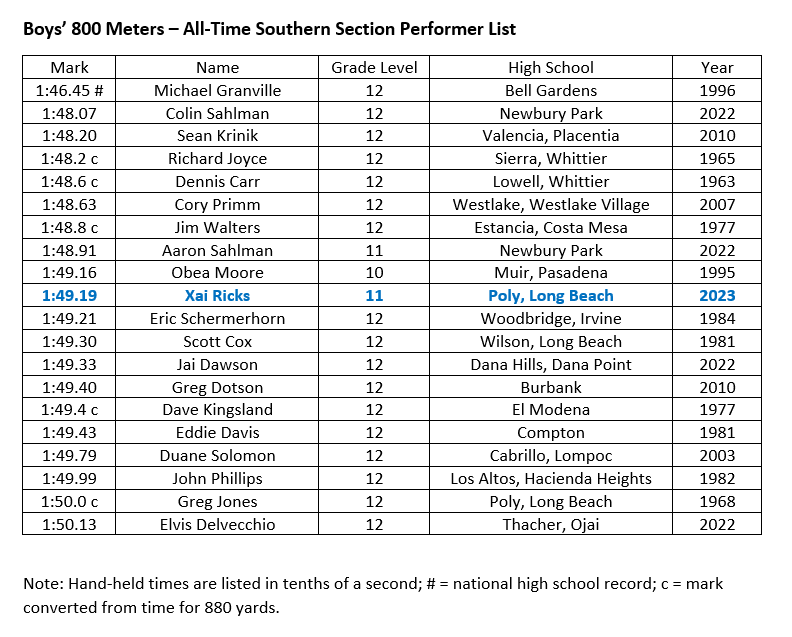Long Beach Poly's Xai Ricks: 'How good does he get?'
Heading into the Arcadia Invitational, junior prep standout in the 400 turns heads with nation-leading and record-breaking times at longer distances

Xai Ricks of Long Beach Poly High School has always loved the 400 meters — and don’t get me wrong, he’s a standout at that — but his performances at longer distances in the last two months have caused both him and his coaches to stop in their tracks.
While the Jackrabbit junior is competing as planned in the boys’ 400 meters and 1,600 relay in the 55th edition of the Arcadia Invitational on Saturday night, his nation-leading time in the 800 last month — following a historic 600 clocking in early February — raises questions about whether the shorter distance is truly his best event.
His most recent stellar effort came in the Azusa Pacific Meet of Champions Distance Classic on March 25 when he surged past Aaron Sahlman of Newbury Park in the home straightaway to win the 800 in 1 minute 49.19 seconds.
That time was the fastest high school performance in the nation this year, moved Ricks to 10th on the all-time Southern Section performer list, and slashed nearly five seconds off his previous best of 1:53.91 that he had run seven days earlier.
“That race made me kind of open up,” he said two days after the Meet of Champions. “It made me think, Oh yeah, the 800 is pretty good for me. But I think I’ll focus more on the four this year. And then come back next year and focus on the eight.”
His breakthrough 800 came two weeks after he had lowered his outdoor best in the 400 to 47.74 and seven weeks after he had run a scintillating 1:16.13 to win the 600 in the California Winter Championships meet on the same Arcadia High track that will host the invitational on Friday evening and all day Saturday. Fifteen days before that monster 600, he had run 47.27 in a qualifying heat of the Under Armour High School Classic indoor meet at Texas Tech University.
The 55th edition of the Arcadia Invitational will start at 5 p.m., Pacific Daylight Time, on Friday with the “Burning Batons” session. The open session of the meet begins at 9:30 a.m. on Saturday.
The invitational session starts with the boys’ discus throw at 3:30 p.m. on Saturday, with track events beginning at 5 p.m.
The meet, which is the most talent-laden in-season high school invitational in the nation each year, will be livestreamed with both live and on-demand video available free of charge.
Assistant Coach Keith Anderson, who is in his 34th season at Poly, says his philosophy is to not get too high with the highs or too low with the lows, but even he was taken aback by Ricks’ recent performances in the longer races.
“I have to admit, that 1:16, that 1:49, they were different. That 1:49 gave you chills. Seeing that, it made you think, What is this kid capable of? What’s going on and where does it stop? How good does he get?”
Crystal Irving, who is in her ninth season as the head boys’ and girls’ coach at Poly and her 26th as a coach with the track and field program at her alma mater, said she has yet to tire of viewing a recording of Ricks’ school-record 800 at Azusa Pacific.
“I've probably watched that race at least 20 times,” she said. “It's just so exciting to hear just a little something different each time, or see something different each time, and the reaction of the fans, the reaction of the announcer, the reaction of the front runner, and just watching closely how Xai reacts after crossing the finish line. Being a class act and congratulating those he ran against.”
Ricks said the 1:49 really surprised him because his training has been geared to the 400, not the 800.
However, he admitted that “coming into the race, I was hoping to [set a personal record], run 1:51 at least. But I was just trying to stay close to Aaron. Within striking distance, because he’s a great runner.”
Ricks, who had run personal bests of 48.16 in the 400, 1:19.92 in the 600, and 1:55.82 in the 800 as a sophomore, placed fourth in the 400 in the Division I race of the Southern Section Finals last year. But his 49.06 clocking in that race was not fast enough to advance him to the Southern Section Masters Meet, the qualifying meet for the California Interscholastic Federation (CIF) State Championships.
Contending for a state title in the 400 was one of his goals at the start of this season, and that’s one of the reasons why he does not intend to drop the one-lap race in favor of the two-lapper this year. He also takes pride in the fact that he competes in the 400, the longest and toughest of the sprint events.
“That’s a big dog race,” he said of the 400. “It takes a lot of guts. There’s a lot of speed there. A lot of speed endurance, which is good.”
Anderson has seen standout 800 runners such as Bryan Woodward (1:50.22 in 1992), Myles Andrews (1:50.63 in 2011), and Chris Hall (1:50.68 in ‘11) come through Poly during his time there. And he will remind you that Andrews and Hall were part of a Jackrabbit foursome that set the still-standing national high school record of 7:28.75 in the boys’ 4 x 800 relay in 2011.
However, he prefers to stick to the training schedule that was laid out for Ricks before the start of the season. He understands it’s fun to speculate about how fast Ricks could run in the 800 if he were to focus on that event, but he feels it’s important for Poly’s coaches to stay consistent with the plans they have designed for their athletes.
“We build things from a training standpoint that will allow us to build the foundation and the steps to reach our goals,” he said.
Irving, who has seen the Poly boys’ and girls’ teams win a combined 15 state team titles since joining the Jackrabbits coaching staff during in the fall of 1997, would like to see Ricks focus on the 400 for the remainder of the season because the team has another high-quality 800 runner in senior Lamarr Kirk Jr., who has run 1:53.15 in the event.
As someone who is always thinking about the best way to maximize her squad’s potential points in meets such as the Southern Section and state championships, she feels it is better to have Ricks and Kirk compete in separate events, rather than the same one in which they could potentially take points away from one another.
Both Anderson and Irving agree that Ricks has benefited greatly from a consistent training program during the current school year, something that was not possible in 2021 or last year because of the COVID-19 pandemic.
After the onset of the pandemic canceled the 2020 prep track and field season across the nation, the 2021 season started several weeks later than usual in California amid a big winter surge of the virus, and the CIF ruled in late April there would be no state championships in any spring sports.
Last year saw the return of the state track and field championships for the first time since 2019, but Anderson said training did not always feel normal because there was always the chance that adjustments might have to be made on the fly if there was a spike in the infection rate of the virus.
Although COVID-19 is still circulating in California and across the U.S., the restrictions related to mitigating its spread have decreased. That has led to more consistent workouts not only on the track, but in the weight room. There athletes can build strength and prevent the type of hamstring injuries that hampered Ricks during his freshman year at Poly when he had bests of 51.45 in the 400 and 1:59.22 in the 800.
“He was hurt part of his freshman year so we had to bring him back kind of slowly,” Irving said. “But then he ran 1:19 [in the 600] last year and was running consistently in the 48s in the 400. . . We’ve just been able to have a consistency in training this year that we haven’t had since the pandemic started, and that has helped everyone.”
Ricks is matter-of-fact when he says, “It took a lot of hard work to get to where I am now.” He has a supreme work ethic, but it is combined with a gregarious personality, according to Anderson.
“He enjoys practice,” Anderson said. “He enjoys improving and working on his craft. He’s on time. He’s a loose kid. Meaning he’s not uptight. He’s very social and very loquacious, and popular among the team. He usually floats around, greeting his constituents, as I like to say. But once we need to get to work, he puts on those track spikes and we get to work. . . We run fast and that’s what he enjoys doing. He’s not afraid to drive himself.”
Mai Ricks, Xai’s twin sister and Poly’s top competitor in the girls’ shot put and discus, describes her brother as a funny and kind person who loves to sing, dance, and tell jokes.
“Xai is very talented and intelligent,” she wrote in a text. “Xai never gives up and when he has his mind set on something he goes for it and is ready for any and all obstacles. I love watching all his races because when Xai steps on that track he is ready to go and shock the world.”
Irving said that in addition to being a hard worker, Xai is always thinking about the team. She recalls that he ran in a couple of cross country meets last fall to help the team when it was in need of another runner. And last week, he was asking Poly’s coaches if they needed him to compete in the high jump, or perhaps the hurdles, the day before they met crosstown rival Long Beach Wilson in a dual meet.
“Even though he's a very talented athlete, he still cheers and encourages his teammates,” Irving said. “He’s that kind of a young man.”
Xai and Mai began competing in track and field when they were very young. Mai took after their mother, Taire Hanson, who had competed in the shot put and discus in high school.
One of Taire’s sisters, Tai-Ne Gibson, was a standout sprinter for Morningside High in Inglewood and ran for USC from 1995-98. But Xai was an 800-1,500 runner at one point during his youth track years before becoming a 400-800 guy as he got closer to high school.
He is aware that most quarter-milers want nothing to do with the 800. But he figures his background in the 800 and 1,500 may have helped him develop a potent combination of what he calls speed endurance.
“I’ve always had the stamina needed for the four and the eight, as well as the fifteen,” he said. “So being able to hold and maintain that speed in the four and the eight has always played a big role for me.”

The strength he spoke about was evident in both the 1:16.13 effort in the 600 in early February and in the 1:49.19 time in the 800 in late March.
In the 600, he came through the first 400 meters between 49 and 50 seconds before running the third – and final – 200 in a little less than 27 seconds.
Jack Shepard, a longtime high school track and field statistician and historian, wrote in an email that although the recording of high school marks in the 600 meters outdoors has been spotty over the decades, “it is likely that Xai Ricks’ 600 is the fastest ever indoors or outdoors. . . There have been only a few 400 or 800 runners who could have run that fast and I never recorded one for them.”
Shepard added that Michael Granville of Bell Gardens High came through the 600-meter mark in 1:17.7 when he set his still-standing national prep record of 1:46.45 in the 800 in 1996.
In the 800 at Azusa Pacific, Sahlman led the field through the first lap in a sizzling 51.68 seconds with Ricks in second place in 53.04.
The Newbury Park senior, who is the fastest returning high school 800 runner in the nation after clocking 1:48.91 last year, increased his lead around the first turn of the second lap and during the first part of the backstretch. But the smooth-striding Ricks did not lose any more ground after that and he began to gradually reduce Sahlman’s lead as he headed into the second turn.
Ricks began to gobble up large chucks of Sahlman’s advantage during the second half of the turn and he sped past the Nike Cross Nationals champion shortly after entering the home straightaway. He finished more than a second and a half ahead of Sahlman (1:50.86), who just held off senior Tarron Johnson of Vista Murrieta in Murrieta (1:50.93) for second place.
“I was still trying to get around him and then go,” Ricks said when asked about his thoughts as he closed in on Sahlman. “I was thinking he’s probably still going to be there with me. But as I passed him, I looked down [the track] at the clock and I’m like, Oh yeah. I just got to go and finish the race. The [time on the] clock was still kind of low.”
Irving, who has watched the video of the race many times, said it set up beautifully for Ricks because he is a chaser, not a pacer.
“I knew that if he got someone in the race who wasn't afraid to take the pace out, I knew he would go with them,” she said. “Xai is a chaser, but he knows how to just wait. He knows how to stay relaxed and then do what he does best at the end.”
Ricks says that coming off the curve at the end of a race is when “I lock in for real and just try to take off. Something there just triggers me.”
Although he plans to make the 400 his primary event for the remainder of the season, Ricks was credited with a 1:53.75 800 leg on a Poly distance medley relay team that clocked a then-yearly nation-leading time of 10:08.97 in the Stanford Invitational on Friday before winning the 400 in 47.74 on Saturday. In addition, he could run an 800 relay leg or two during the high school portion of the Mt. San Antonio College Relays in Walnut on April 15.
After running 47.27 in the 400 indoors and twice clocking 47.74 outdoors, Ricks would love to break 47 for the first time in the Arcadia Invitational. But in order to do that, he figures he will need to get out faster for the first 150-200 meters than he is accustomed to doing.
Even if he does that, he still might find himself trailing some of his fellow entrants in the race.
Dijon Stanley of Granada Hills Charter has run a personal best — and yearly state-leading time — of 46.40. Fellow senior Arden Parker of Helix Charter in La Mesa has run 47.03 this year after lowering his personal best to 46.82 in a qualifying heat of the state championships last year. He finished fourth in the final, one place behind Stanley.
“The last 120 has to be hot,” Irving said when talking about success in both the 400 and 800. “We always talk about finishing with our athletes. That you have to complete the race. You need to save something for that last part. That you can't just give it all up at the beginning and have nothing left at the end.”
Ricks has shown the ability to finish strong in the 400, 600, and 800 this year. And though he does not expect to run another open 800 this season, his 1:49.19 effort has him looking at the race in a different light.
“The 800 is starting to be more like a sprint,” he said. “You have to have endurance, but you also have to have speed and be able to maintain it and just keep running.”




